Research Article Open Access
Comparative Influence of Brassinosteroids Correspondents (24-Epibl and 28-Homobl) on the Morpho-physiological Constraints of Brassica oleracea (Cabbage, Cauliflower and Broccoli)
| Spall Kaur Nirmal K1, Geetika Sirhindi1and Sandeep Kumar1,2* | |
| 1Department of Botany, Punjabi University, Patiala-147002, India | |
| 2Deen Dayal Upadhyaya College, University of Delhi, Karampura, New Delhi-110015, India | |
| Corresponding Author : | Dr. Sandeep Kumar Assistant Professor, Department of Botany, Deen Dayal Upadhyaya College University of Delhi, Karampura, New Delhi-110015, India and Department of Botany Punjabi University, Patiala-147002, Punjab, India Tel: + 91 9810685352 E-mail: sandeep20684@gmail.com |
| Received: December 16, 2015; Accepted: December 23, 2015; Published: January 10, 2016 | |
| Citation: Spall Kaur Nirmal K, Sirhnidi G, Kumar S (2016) Comparative Influence of Brassinosteroids Correspondents (24-Epibl and 28-Homobl) on the Morphophysiological Constraints of Brassica oleracea (Cabbage, Cauliflower and Broccoli) Biochem Physiol 5:193. doi:10.4172/2168-9652.1000193 | |
| Copyright: © 2016 Spall Kaur Nirmal K, et al. This is an open-access article distributed under the terms of the Creative Commons Attribution License, which permits unrestricted use, distribution, and reproduction in any medium, provided the original author and source are credited. | |
Visit for more related articles at Biochemistry & Physiology: Open Access
Abstract
Influence of brassinosteroid correspondent viz. 24-epiBL and 28-homoBL were studied on morpho-physiological constraints of 10th DAS of Brassica oleracea viz. (cabbage, cauliflower and broccoli). Seed priming treatments with various concentrations of 24-epiBL and 28-homoBL (10–6 M, 10–9 M and 10–12 M) were applied and observed that BRs treatments encourages seed germination significantly as compared to untreated seeds on 3 and 4th DAS. Seed priming treatments with above mention concentrations of 24-epiBL and 28-homoBL exaggerated the morphology of 10th seedlings of cabbage, cauliflower and broccoli on various extents, as root length was found to be inhibited by all treatments in all the varieties but shoot length enhanced significantly in all varieties with all the treatments. Results also suggested that BRs works best on optimal concentration, i.e., 10–9 M in 24-epiBL. Photosynthetic pigments i.e. total chlorophyll, chlorophyll a and b, carotenoids were also influenced by the treatments of 24-epiBL and/or 28-homoBL but the influence was very much dose dependent and optimum dose was varying variety to variety. As there is a direct correlation between the photosynthetic pigment and carbohydrate synthesis so study also suggest that the accumulation of carbohydrate also ameliorated after seed priming treatments. In conclusion it was found that BRs works in dose dependent manner and optimum dose varying variety to variety. Broccoli responded most efficient to BRs treatments and 24-epiBL has more potential to promote morpho-physiological parameters of Brassica oleracea varieties.
| Keywords |
| 24-epiBL; 28-homoBL; Brassica oleracea; Cabbage; Cauliflower; Broccoli; Photosynthetic pigments; Proteins; Carbohydrates |
| Abbreviations |
| 24-epiBL: 24-epibrassinolde; 28-homoBL: 28-homobrassinolide; BRs: Brassinosteroids; DAS: Day Old Seedlings; DDW: Double Distilled Water; DW: Distilled Water |
| Introduction |
| Brassinosteroids (BRs) are endogenous plant hormones essential for the proper regulation of multiple physiological processes required for normal plant growth and development. BRs also have dramatic pleiotropic effects on a broad range of diverse developmental pathways i.e. cell division and cell elongation, photo-morphogenesis, reproductive development, leaf senescence and also in stress responses and have further pointed to BRs interactions with other plant hormones and environmental cues [1,2]. Clouse and sasse [3] revealed that brassinosteroids are required for normal growth and development of plants along with this it also play a crucial role under stress condition as reported by Kumar et al. [4] and Sirhindi et al. [5] in Brassica juncea L. under temperature stress. It also has the ability to enhance the metabolic reactions by enhancing activity of some enzyme reported under seasonal condition [6]. Exogenous application of brassinosteroid in agriculture to promote plant growth, production and quality is becoming very common now a day. BRs exhibit a prominent role in various physiological processes when sprayed on young cucumbers and are now widely used to enhance plant growth and yield of important agricultural crops as recognized by Jiang et al. [7]. |
| Brassica oleracea belongs to family Brassicacea is a rabi crop, grown in tropical region of India. Popularly known as wild cabbage from which numerous vegetable crops have been derived including broccoli, cabbage and cauliflower. The Food and Agriculture Organization of the United Nations (FAO) reported nutritional and medicinal properties of cabbage, cauliflower, broccoli and other brassicas. Cabbage is an excellent source of Vit C and Vit K, containing more than 20% of the Daily value (DV) for the nutrients. Basic research on cabbage phytochemicals is ongoing to discern if certain cabbage compounds may affect health or have anti-oxidant potential, protective against colon cancer. Brassica oleracea, being a cold seasoned crop is frequently exposed to dynamic fluctuations of seasonal stress imposing shocking stress leading to loss of crop productivity. In this study an attempt has been made to explore the potential use of BR as positive or stimulatory consequence on morpho-physiological constraints in cauliflower, cabbage and broccoli. |
| Materials and Methods |
| Seeds of Brassica oleracea var. cauliflower, cabbage and broccoli were procured from Punjab Agricultural University, Ludhiana, Punjab. Seeds were surface sterilized with hypochlorite and rinsed 5-6th times with DDW and primed with 24-epiBL and 28-homoBL concentrations (0, 10-6, 10-9, 10-12 M) for 8th hours and DW as control. The treated seeds were sown in three replications. Morphological data in terms of seedling growth germination, shoot length, root length, fresh weight and dry weight were measured on 10th day excluding germination it was observed on 3rd and 4th day. The dry weight was calculated by using formula Dry weight=dry weight/fresh weight × 100. The samples were harvested for the various biochemical analyses 10 DAS. |
| Determination of pigments (Chl a, b and carotenoids) |
| Total chlorophyll (Chl), chlorophyll a, b and carotenoid (Car) content were quantified by following the method of Lichtenthaler et al. [8]. Fresh leaves were homogenized in 3.0 ml of 70% acetone followed by its centrifugation at 12000X g for 15 min. Absorbance of supernatant was observed at 645, 663 and 470 nm and 70% acetone was taken as blank. |
| Determination of carbohydrate, sugar, reducing and reducing sugar content |
| Carbohydrate content was estimated by the method of Dubois et al. [9]. Reaction mixture contains phenol reagents, H2SO4 and samples were incubated at room temperature for 30 minutes. Absorbance was taken at 485 nm and amount of carbohydrate was expressed as mg g-1 fresh weight. |
| Total sugar was estimated following the method of Loewus [10]. Reaction mixture contains 0.05 ml of ethanol extract added 0.95 ml of distilled water and then added 3ml cold anthrone reagent with constant shaking. Reaction mixture was heated for 10 min in boiling water bath and cooled rapidly at room temperature. Absorbance was measured at 630 nm. Amount of total sugars content was calculated and expressed as mg g-1 fresh weight. |
| Reducing sugar content was estimated by the method of Nelson [11]. Absorbance was measured at 620 nm expressed as mg gΓΆΒ?Β?1 fresh weight. Non reducing sugar was calculated by subtracting the reducing sugars content from the total sugar and expressed as mg gΓΆΒ?Β?1 fresh weight. |
| Determination of protein content |
| Protein estimation was done following the method of Lowry et al. [12]. |
| Statistical analysis |
| All analyses were done on a completely randomized design. All data obtained was subjected to one-way analysis of variance (ANOVA) and the differences between means were compared using Duncan’s multiple range tests. Each data was the mean of three replicates (n=3) except for shoot lengths of Brassica oleracea var. cauliflower, cabbage and broccoli (n=10) and comparisons with P-values <0.05 were considered significantly different. |
| Results |
| Priming treatment with different concentrations of 24-epiBL and 28-homoBL exposed 2% higher rate of germination in 3 DAS than control untreated seed in all the studied varieties. Maximum germination recorded with 10–9 mM epiBL (98.5%) in var. italica; (97.4%) in var. capitata and (95.9%) in var. botyritis compared with control (96.67%, 95.2% and 94.5% respectively) seedlings (Table 1). Fresh weight and dry weight were evaluated and var. italica promoted significantly on priming with 10–9 mM epiBL an increase in 9.68% fresh weight of the control value. A similar trend in increase in fresh weight and dry weight was revealed in var. capitata and botyritis. Increase in shoot length was recorded in all the primed treated varieties to control and effective amelioration in length was seen in 10–6 mM homoBL in var. italic (Table 1). The experimental data revealed maximum root length in control in all the experimental varieties. Inhibition of root length in BRs primed seeds was observed in all the treatments of brassinosteroids. Brassinosteroids treatment significantly influenced the photosynthetic pigments. 13% increase of chlorophyll a (23.33 ± .05) was recorded in primed seeds with 10–9 mM epiBL to control in all the varieties (Figure 1). Chlorophyll b increased by 12% in treated 10–9 mM homoBL (18.60 ± 0.06) to control (15.33 0.05) in all treated varieties (Figure 2). Total chlorophyll content exhibited highest in italica (10.8%) to control in 10–9 mM epiBL/homoBL in all varieties (Figure 3). Carotenoid content was found highest (14.7%) in primed treated seeds with 10–9 mM epiBL in var. botrytis (3.76 ± 0.08) when compared to control (2.55 ± 0.08) as shown in Figure 4. An increase of carotenoid pigment (11.5%) in var. capitata was found with 10–9 mM homoBL whereas var. italica responded 13% more than untreated control. Total soluble sugars elevated (10.8%) in all the three varieties in treated seedlings. Maximum content was revealed in italica 10–9 /10–12 mM homoBL (Figure 5). Total reducing sugars and non-reducing sugars was exhibited highest (13.9% and 13.6%) in capitata with 10–9 mM epiBL treatment (Figures 6 and 7). Carbohydrate content in primed seeds of italica and capitata augmented (11.4%–11.8%) to untreated control. An increase of 12.2% in primed treatment with 10–9 mM epiBL to control was observed in var. botrytis (Figure 8). An increase of protein content was displayed in all the treated varieties. Protein content was found to be enhanced by 11.3% on priming with 10–9 mM epiBL in var. capitate as shown in Figure 9. |
| Discussion |
| The importance of BRs in a broad range of developmental processes implies the existence of mechanism controlling both endogenous level and distribution of BRs in the target cells or tissues. An integrated understanding of the BRs in plant developments requires a deep understanding of the way plants modulate the endogenous levels of and responsiveness to endogenous BRs. BRs deferentially affected the germination and elongation of shoot in Brassica oleracea. Exogenous application of BRs stimulates the rate of germination with attenuation of epiBL/homoBL and the improvement in rate of seed emergence was found to be dose dependent in manner. 10–9 mM epiBL/homoBL appealed to be prominent as to other concentrations and control. Hayat and Ahmed [13], Ali et al. [14] and Kumar et al. [15] also acknowledged same results while them working with different concentrations of BRs in wheat, Cicer arietinum and B. juncea L and was found 10-8 mM was best for seed germination as compared to untreated seeds. They also confirmed that seed germination enhanced by 28-homoBL due to the increase in activities of α-amylase, catalase, peroxidase, along with increase in total soluble sugars and protein content. |
| Progressive enhancement of the elongation of primary shoot length, fresh weight and dry weight associated with the treatments of 24-epiBL/28-homoBL in Brassica oleracea compared to untreated control seeds. Shoot Elongation Enhancement is associated by the expression of α-Expansin and Xyloglucan Endotransglucosylase/Hydrolase Genes and activities of these enzymes are increase with the increase level of BRs concentration in cells or targeted tissues. Similar progressive enhance was reported by Nassar [16] in banana shoot culture that was supplemented with of 28-homoBL Shahid et al. [17] also reported ameliorative effect of BRs on shoot length in Pisum sativum L. |
| Root system architecture is one of the most important traits affecting the efficiency of plant by which a plant explores the soil and captures limiting supplies of water and nutrients [18]. A well-known example of root developmental plasticity is represented by the “dual pathway” controlling the lateral root growth in response Nutrient by one way and another way is controlled by hormone [19]. Reduction of primary root in all the studied varieties of B. oleracea by BRs treatment may be due to the stimulation of ethylene production. BRs have been demonstrated to stimulate 1-amino-cyclopropane-1-carboxylic acid (ACC), the immediate precursor of ethylene in higher plants, exogenously applied BRs enhance ethylene release and ACC oxidase activity in dose dependent manner in ethylene biosynthesis system such as primary root [20]. This hormone and ACC oxidase enzyme play a role in inhibition of root length in B. oleracea plants. |
| In two wheat varieties, Sairam et al. [21] observed enhanced chlorophyll content and photosynthesis under irrigated and water deficit condition after the treatment of 28-homoBL. Prior treatments with BRs resulted in significant increase in the rate of photosynthesis. Similarly present study indicates an increase in chlorophyll content of Brassica oleracea by exogenous application of epiBL was reported by Cao et al. [22]. Carbohydrate content and total soluble sugars content were also enhanced with the application of epiBL/homoBL treatments. This study is supported by Bajguz and Asami [23] in Wolfia arriza, exogenous supply of 10–9 mM EBL to cell cultures accumulated high sugar content as compared to control. An increase in carbohydrate content in tomato (Lycopersicum esculentum) by BR application was investigated by Vardhini et al. [24]. |
| Ameliorative effect on protein content in all the varieties of Brassica olearacea studied elucidated the investigation of Farriduddin et al. [25] in Vigna radiata that protein content increased after spray of 28-homoBL. Pustovaitova et al. [26] reported that epiBL increased drought resistance of cucumber plants by enhancing the content of free amino acids and amides. Application of 28-homoBL to wheat plants has been shown to enhance soluble protein content, relative water content, nitrate reductase activity and chlorophyll content. |
| Conclusion |
| Application of analog form of BRs ameliorated the morphological and physiological parameters and inhibited root length in all the three varieties of B. oleracea. The metabolic machinery is activated on priming with the hormones. The increase in various parameters reveals that the response of BRs is dose dependent in all the varieties. The knowledge of the physical and chemical properties of these steroids allures us to consider them as a highly promising and environmental friendly promoter of agricultural productivity and a potent stress alleviator. |
| Acknowledgements |
| This work has been supported by Department of Botany, Punjabi University, Patiala. |
References
|
Tables and Figures at a glance
| Table 1 |
Figures at a glance
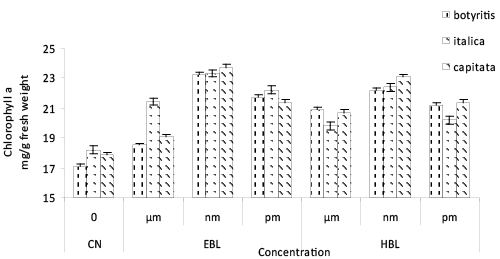 |
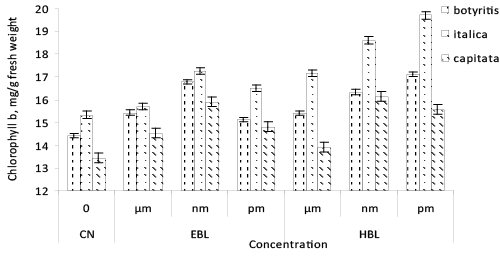 |
 |
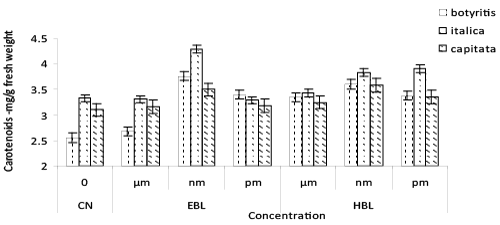 |
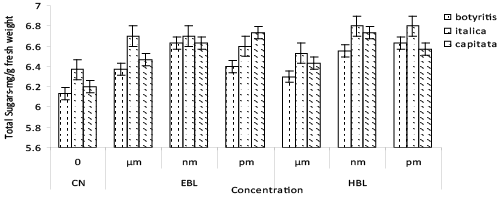 |
| Figure 1 | Figure 2 | Figure 3 | Figure 4 | Figure 5 |
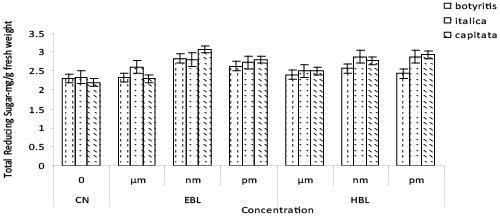 |
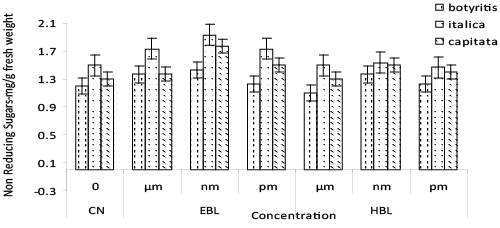 |
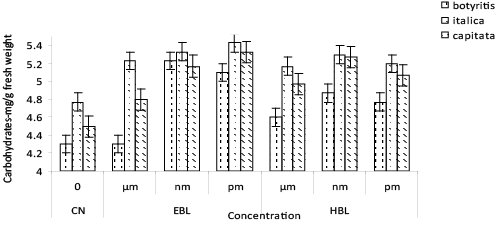 |
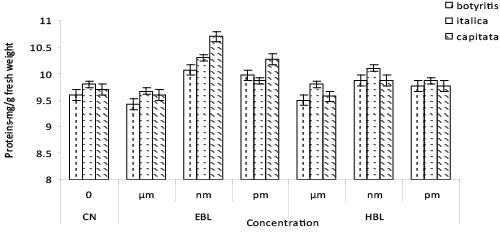 |
| Figure 6 | Figure 7 | Figure 8 | Figure 9 |
Relevant Topics
- Analytical Biochemistry
- Applied Biochemistry
- Carbohydrate Biochemistry
- Cellular Biochemistry
- Clinical_Biochemistry
- Comparative Biochemistry
- Environmental Biochemistry
- Forensic Biochemistry
- Lipid Biochemistry
- Medical_Biochemistry
- Metabolomics
- Nutritional Biochemistry
- Pesticide Biochemistry
- Process Biochemistry
- Protein_Biochemistry
- Single-Cell Biochemistry
- Soil_Biochemistry
Recommended Journals
- Biosensor Journals
- Cellular Biology Journal
- Journal of Biochemistry and Microbial Toxicology
- Journal of Biochemistry and Cell Biology
- Journal of Biological and Medical Sciences
- Journal of Cell Biology & Immunology
- Journal of Cellular and Molecular Pharmacology
- Journal of Chemical Biology & Therapeutics
- Journal of Phytochemicistry And Biochemistry
Article Tools
Article Usage
- Total views: 10791
- [From(publication date):
March-2016 - Apr 03, 2025] - Breakdown by view type
- HTML page views : 9888
- PDF downloads : 903
